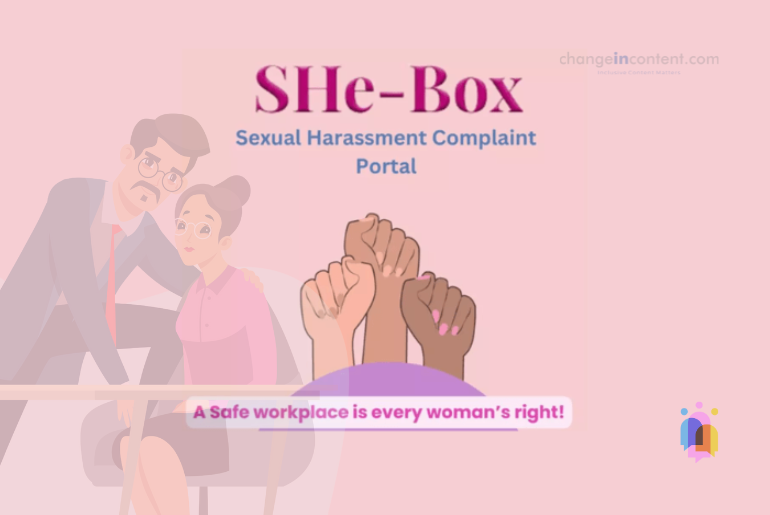Amid rising concerns about workplace safety and inclusivity for women, the Union Ministry of Women and Child Development (WCD) has taken a crucial step by launching the SHe-Box portal for women’s safety in the workplace. This initiative aims to provide women with a centralised platform to register, monitor, and address workplace sexual harassment complaints. Moreover, the portal allows users to do so regardless of whether they work in organised or unorganised sectors.
This platform aligns with the government’s ongoing commitment to creating a safer working environment for women. It is one of the various initiatives as a part of the government’s vision for a Viksit Bharat by 2047. The new SHe-Box portal is a significant enhancement in protecting women from sexual harassment in the workplace. It builds on the framework provided by the 2013 Sexual Harassment of Women at Workplace (Prevention, Prohibition, and Redressal) Act. By streamlining the complaint process and enhancing accountability, this move promises to play a pivotal role in women-led development across the nation.
SHe-Box portal for women’s safety: How does it work?
The SHe-Box portal functions as a central repository for all complaints related to sexual harassment in the workplace. Whether an employee works in the government, public, private, organised, or unorganised sector, the platform allows women to file complaints. Additionally, it will enable women to track their complaints in real time.
Once registered, the complaint is directed to the concerned authority. That will ensure a prompt response. A designated nodal officer monitors each complaint. As a result, the portal allows for seamless tracking and real-time updates on the resolution process. Furthermore, the portal guarantees confidentiality. It ensures that personal information remains secure and is not publicly accessible.
The SHe-Box portal consolidates information from Internal Committees (ICs) and Local Committees (LCs), which the 2013 Act mandates to be established in both government and private sectors. These committees are responsible for investigating and resolving sexual harassment complaints in workplaces across the country. The portal serves as a unified platform to support these efforts.
The importance of a centralised system for women’s safety
Workplace sexual harassment remains a significant challenge across India. While many organisations have set up Internal Committees (ICs), the effectiveness of these systems varies widely. Many women still feel hesitant to come forward with complaints due to fears of retaliation or concerns that the concerned authorities will not take their complaints seriously. In this context, the SHe-Box portal is a significant milestone in creating a more inclusive and responsive mechanism for addressing workplace harassment.
By allowing women from every sector to file complaints online and monitor their status, the portal provides a much-needed tool to bridge the gaps in existing systems. This development holds particular importance for women in unorganised sectors. Not to forget, the unorganised sector is where the risk of harassment is often higher. Moreover, the mechanisms for addressing such grievances are less structured or non-existent in the unorganised sector.
Measurability with the SHe-Box portal for women’s safety
The SHe-Box portal also measures employers’ accountability. By allowing companies to monitor complaints and track them in real-time, companies are encouraged to respond quickly and take appropriate action. It ensures that workplace harassment cases get the serious treatment they deserve.
What more needs to be done
While the SHe-Box portal is a decisive step forward, addressing sexual harassment requires more than just the implementation of a digital tool. There is a growing recognition of the need for a change in mindset across India’s workplaces. Cultural transformation, driven by constant training and education, is critical to creating an environment where women feel safe and empowered to come forward with complaints.
Organisations must ensure that their POSH (Prevention of Sexual Harassment) policies are more than just a formality. Consistent training, open conversations, and a clear commitment from leadership must ensure a workplace culture with zero tolerance towards harassment. Beyond that, government bodies must continue to strengthen enforcement. They must ensure that companies that fail to comply with POSH regulations face meaningful consequences.
Additionally, as digital tools like SHe-Box gain traction, it is crucial to address concerns around digital literacy and access. It is particularly important for women in rural and unorganised sectors. Many of these women may not have access to the internet or the knowledge of how to use online platforms like SHe-Box. Ensuring that these barriers are addressed will be critical to the platform’s success in genuinely reaching all women across India.
Final thoughts: A step forward, but more is needed
The launch of the SHe-Box portal for women’s safety represents a vital step toward safer, more inclusive workplaces across India. By centralising the process of filing and tracking complaints, the portal provides a more transparent, streamlined, and accessible means of addressing sexual harassment in the workplace.
However, as with any initiative, the success of the SHe-Box will depend on its implementation and widespread adoption. More importantly, a broader cultural shift must support the adoption. We must build a culture that involves continued education, stricter enforcement of POSH policies, and stronger accountability measures for organisations that fail to provide safe environments for women.
Ultimately, creating genuinely inclusive workplaces in India will require sustained efforts from both the government and the private sector. Ultimately, it requires a strong commitment to empowering women and upholding their rights.
Disclaimer: The views expressed in this article are based on the writer’s insights, supported by data and resources available both online and offline, as applicable. Changeincontent.com is committed to promoting inclusivity across all forms of content, which we broadly define as media, policies, law, and history—encompassing all elements that influence the lives of women and gender-queer individuals. Our goal is to promote understanding and advocate for comprehensive inclusivity.


